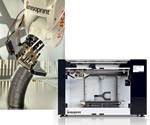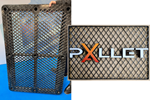Post Cure: Parallel winding technique demonstrates CFRP anisogrid design optimization
Over the years, CIRA has demonstrated its patented CFRP parallel winding technique in a variety of ways for space applications. The lattice structure for the Vega-C launcher stage is a prime example.
Over the last two decades, CIRA, the Italian Aerospace Research Centre (Capua, Italy) has modified and refined its patented parallel winding technique, which can achieve scalable, interlaced, carbon fiber-reinforced polymer (CFRP) anisogrid lattice structures.
The process involves a combination of dry fiber robotic filament winding for helical ribs, and parallel winding for hoop ribs. Simultaneous helical winding around pins and parallel hoop winding quickly and efficiently achieves interlacing of the ribs without the need for cutting tows, nor dummy helices, between hoops. The completed dry interlaced preform is then vacuum bagged and infused with resin, and finally cured in or out of autoclave, depending on resin and part requirements.
Lattice winding guarantees homogeneous rib sections through the crossing nodes without the typical distortion seen with prepregs. Also, even if the rib fiber volume fraction is limited to near 35%, stiffness and strength properties are still high, achieving 20% mass reduction with respect to other composite configurations in cases of high compressive load.
Over the years, CIRA has demonstrated the technologies’ capabilities to produce everything from large interstage, central tubes and payload adapters to long booms for large, deployable antennas for medium-class satellites.
Shown here is the Vega-C launcher Interstage 2/3, measuring 2.4 meters in diameter and 2 meters long. It is now produced serially by Avio SpA (Colleferro, Italy) using CIRA’s technology, which is operative at Avio’s facility.
Read more about this process and some of CIRA’s projects.
Related Content
-
Industrializing additive manufacturing in the defense/aerospace sector
GA-ASI demonstrates a path forward for the use of additive technologies for composite tooling, flight-qualified parts.
-
Plant tour: Aernnova Composites, Toledo and Illescas, Spain
RTM and ATL/AFP high-rate production sites feature this composites and engineering leader’s continued push for excellence and innovation for future airframes.
-
Sulapac introduces Sulapac Flow 1.7 to replace PLA, ABS and PP in FDM, FGF
Available as filament and granules for extrusion, new wood composite matches properties yet is compostable, eliminates microplastics and reduces carbon footprint.

















